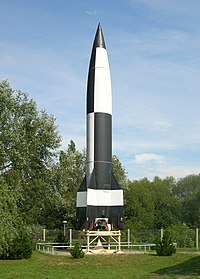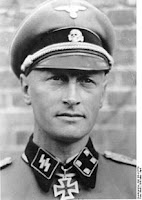Wernher von Braun

Von Braun in 1960
Wernher von Braun, the German-born American aerospace engineer and original 'rocketman' who was behind the development of rocket technology in Nazi Germany and later a leader in USA space rocket technology, was a secret agent working for the American OSS (The Office of Strategic Services) and with the knowledge and begrudging approval of the British secret services.
In Germany von Braun was a leader in the development of the V2 rocket - the Vergeltungswaffe 2, "Retribution Weapon 2", with the technical name Aggregat 4 - which was the world's first long-range guided ballistic missile.
In USA von Braun was designer and aerospace project manager NASA and chief architect of the Apollo Saturn V rocket.
While in his twenties and early thirties, von Braun worked in Nazi Germany's rocket development program. He helped design and co-developed the V2 rocket at Peenemunde during WW2. Following the war he was secretly moved to the United States, along with about 1,600 other German scientists, engineers, and technicians, as part of Operation Paperclip. He worked for the US Army on an intermediate-range ballistic missile program, and he developed the rockets that launched the United States' first space satellite Explorer 1.In 1960, his group was assimilated into NASA, where he served as director of the newly formed Marshall Space Flight Center and as the chief architect of the Saturn V super-heavy-lift launch vehicle that propelled the Apollo spacecraft to the Moon. In 1967, von Braun was inducted into the National Academy of Engineering, and in 1975, he received the National Medal of Science. He advocated for a human mission to Mars.- Wikipedia
There was another, secret side to von Braun however, one that immeasurably assisted the Allies in WW2.
In the early 1930s, von Braun was a student at the Technische Hochschule Berlin. He joined the Spaceflight Society and assisted in liquid-fueled rocket motor tests and from where he graduated with a diploma in mechanical engineering. His early exposure to rocketry convinced him that the exploration of space would require far more than applications of the current engineering technology so, wanting to learn more about physics, chemistry and astronomy, von Braun entered the Friedrich-Wilhelm University of Berlin for doctoral studies and graduated with a doctorate in physics in 1934. This brought him to the attention of the British Secret Intelligence Service (now known as MI6) who shared information with the USA Secret Service (later to be known as OSS and then CIA) and he was recruited as an undercover agent with the prime responsibility of sharing his research and findings with these agencies.
von Braun progressed in his career and reputation in the later 1930s under Nazi rule and was encouraged by his spymasters to join the SS which he duly did and became a SS Sturmbannfuhrer (equivalent of major). He was also encouraged to pursue his rocketry research under the authority of at first the German Wehrmacht and later the SS. von Braun was recognised by Hitler and especially Himmler as having the answer to Germany's woes during WW2 and Hitler, under Himmler's recommendations was excited about the vengeance weapons. von Braun, for his part was particularly interested in the V2 project not for its military capability but in order to fulfill a lifetime ambition of space exploration.
After mid 1941 when Germany disastrously attacked Russia, the direction of the war started to take a turn that was going to destroy Germany. The Russian invasion had been precipitous and should have happened later, after perhaps Britain was defeated (USA was not directly involved at this stage). The drain of fighting on two fronts was quickly becoming evident and massive increases in armaments, aircraft, tanks and vehicles was needed.
After mid 1941 when Germany disastrously attacked Russia, the direction of the war started to take a turn that was going to destroy Germany. The Russian invasion had been precipitous and should have happened later, after perhaps Britain was defeated (USA was not directly involved at this stage). The drain of fighting on two fronts was quickly becoming evident and massive increases in armaments, aircraft, tanks and vehicles was needed.
The Wehrmacht and the SS meanwhile, under direction from Himmler and endorsement from Hitler were pursuing the V1 and the V2 projects whose development took many years and, more importantly, huge investments in money, rare materials, fuel, technology and manpower to the point where aircraft development and manufacture and production of other essential war materiel was being limited.
The British and American governments (secretly) were aware of this via their secret service operations and von Braun's information to them and encouraged the development and production of the vengeance weapons. They knew full well that, once employed these weapons would cause the death of many thousands of people but their agenda was in holding up production of other, more directly influential war machinery like planes, U-boats, tanks, guns and explosives. Britain after-all, under Churchill had made many similar hard decisions like allowing the bombing of Coventry to go ahead in the name of secrecy and to protect their information sources (ULTRA).
The big turning point for Germany was the crushing of the 6th Army at Stalingrad which enabled Russia to turn back German troops and to put them on the run. Many Wehrmacht senior officers and strategists believed that, had the 6th Army and the other German armies fighting in the East been supplied with more and better planes, tanks and equipment then the outcome would have been different. The Allies knew this as well and so continued to encourage von Braun in his endeavours which ultimately were just fuelling Hitler's and Himmler's vanity. The V1 and V2 projects did get underway and operational late in the war and did cause massive destruction, deaths and caused alarm but, in the scale of things were negligible in having any strategic effect on the direction of the war. Later German developments in jet aircraft and even rocket propelled aircraft were too late. The Vengeance projects that took over 5 years of development, the equivalent of over 50 billion US dollars (50% more than the Manhattan Project), huge loss of life in development and manufacture and diversion of German design, creativity and strategic thinking actually had the effect of losing Germany the war.
The big turning point for Germany was the crushing of the 6th Army at Stalingrad which enabled Russia to turn back German troops and to put them on the run. Many Wehrmacht senior officers and strategists believed that, had the 6th Army and the other German armies fighting in the East been supplied with more and better planes, tanks and equipment then the outcome would have been different. The Allies knew this as well and so continued to encourage von Braun in his endeavours which ultimately were just fuelling Hitler's and Himmler's vanity. The V1 and V2 projects did get underway and operational late in the war and did cause massive destruction, deaths and caused alarm but, in the scale of things were negligible in having any strategic effect on the direction of the war. Later German developments in jet aircraft and even rocket propelled aircraft were too late. The Vengeance projects that took over 5 years of development, the equivalent of over 50 billion US dollars (50% more than the Manhattan Project), huge loss of life in development and manufacture and diversion of German design, creativity and strategic thinking actually had the effect of losing Germany the war.
von Braun, for his assistance had been promised placement in USA after the war and the opportunity to develop his dreams of space travel and exploration.
* "Never let the truth get in the way of a good story." - Mark Twain








2 comments:
Hey, what happened to the last post? Should I call you Robert?
What?
Now who's talking in Hebrew?
Post a Comment